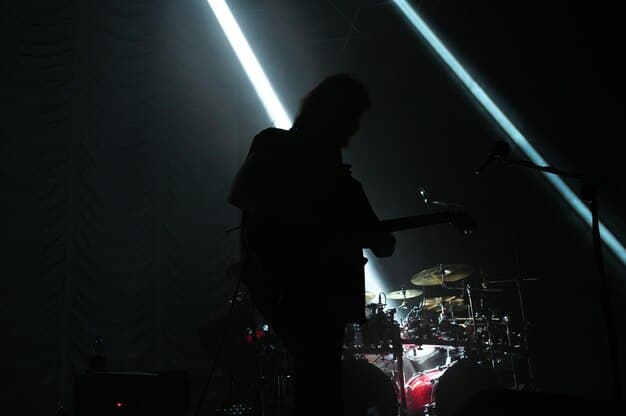Metalcore Breakdown: Deconstructing the Genre’s Signature Element

Metalcore breakdowns are defining moments in songs, characterized by a shift to slower tempos and heavy emphasis on rhythm, creating intense anticipation and release.
Have you ever been swept away by the sheer force of a metalcore breakdown? These moments of sonic devastation are more than just heavy parts; they’re the climactic release that defines the genre. Let’s dive in and dissect what makes them so effective.
Understanding the Metalcore Breakdown
The metalcore breakdown is integral to the genre. It’s not just a heavy part; it’s often the most anticipated moment in a song. But what exactly makes up a breakdown, and why is it so effective?
The Core Elements of a Breakdown
At its heart, a breakdown is a deceleration and simplification of the music. Often, blast beats and complex riffing give way to chugging guitars and a slower, more rhythmically focused approach.
Purpose and Effect
The purpose of a breakdown is to create tension and release. By stripping down the song to its most basic elements and often introducing a syncopated rhythm, it builds anticipation for a heavier section.

Breakdowns are effective because they provide a dynamic contrast to the rest of the song. They offer a moment for the listener to catch their breath before launching back into higher energy sections, or they serve as the ultimate climax of the song.
- Creates dynamic contrast in a song.
- Offers a moment of tension building before climax.
- Allows audience engagement during live shows.
In conclusion, metalcore breakdowns offer intense points within the song in which the tempo slows down and rhythm is heavily emphasized, which creates tension and anticipation.
The Evolution Of The Breakdown
The breakdown hasn’t always been the same. It has evolved significantly since the early days of metal and hardcore. Its modern form is a hybrid, influenced by various styles and techniques.
Origins in Hardcore Punk
Breakdowns originally emerged in hardcore punk, where they were used to allow the crowd to participate with moshing and stage diving. Bands like Agnostic Front pioneered these simplified, heavy sections.
Metal Influences
As hardcore evolved into metalcore, bands started incorporating metal elements into their breakdowns, such as heavier distortion, drop tunings, and more complex rhythmic patterns.

This fusion created a new type of breakdown, one that was both aggressive and technically proficient, setting the stage for modern metalcore.
The evolution of breakdowns show the transformation across genres, from hardcore punk to modern metalcore, incorporating distorted guitars and rhythmic patterns.
Techniques and Rhythmic Structures
There are many ways to construct a breakdown. Bands employ several techniques to create different sounds and atmospheres. It’s not just about playing slowly; it’s about crafting a specific feel.
Drop Tunings
Using drop tunings, such as Drop D or Drop C, is a common technique. These lower tunings provide a heavier, more guttural sound that is perfect for breakdowns.
Syncopation and Off-Beats
Syncopation, or emphasizing the off-beats, is another effective tool. It creates a sense of unease and anticipation, making the eventual release even more impactful.
- Utilizing unconventional time signatures to unsettle the listener.
- Emphasizing the off-beats to create anticipation.
- Employing palm-muted power chords for the distinctive sound.
Moreover, metalcore bands often mix technical metal elements with traditional hardcore elements. This combination is especially apparent in the rhythm section, where complex drumming combines with simple, repetitive guitar riffs to create an intense, yet straightforward, sonic assault.
In conclusion, various techniques work together to shape the unique and intense sound. Drop tunings along with syncopation provide the distinctive and effective sound.
The Role of the Breakdown in Song Structure
The placement and execution of a breakdown can make or break a song. If used correctly, it can be the defining moment. If mishandled, it can feel forced or out of place.
Placement
A well-placed breakdown often comes after a period of building tension, such as a chorus or a fast-paced verse. This placement ensures maximum impact. A breakdown positioned towards the end of a song serves as a decisive, resonating conclusion.
Build-Up
Effective breakdowns are almost always preceded by a build-up. This could be a gradual slowing of tempo, a decrease in instrumentation, or a combination of both.
These elements gradually lead the listener towards the breakdown. If the build-up is not well done, the breakdown might feel out of place within the song’s narrative. The most compelling breakdowns often catch the listener by surprise and this element of surprise can significantly increase its impact.
Breakdowns work better if there is enough build-up. Timing is everything, especially in metalcore, and a great breakdown can leave a lasting impact. A poor build-up can come across as forced while good placement creates anticipation for the listener.
Impact on Live Performances
Breakdowns are particularly effective in live settings. They encourage crowd participation and create a sense of collective energy. This is where their hardcore roots truly shine.
Moshing and Headbanging
Breakdowns are inherently mosh-friendly. The slower tempo and emphasis on rhythm make it easier for the audience to move and engage with the music. A lot of times the audience participation intensifies.
Call and Response
Many bands use breakdowns as an opportunity for call and response with the crowd. The vocalist might scream a phrase, and the crowd responds in kind, amplifying the energy in the room.
These moments bridge the gap between the band and the audience, and it transforms a performance into a more collaborative experience. Breakdowns provide an excellent opportunity for bands to interact with their fans and create a shared moment of intensity and passion. They truly create an unforgettable and engaging atmosphere.
- Moshing and headbanging.
- They allow call and response opportunities for the vocalist and the audience.
- The band and the audience become more interconnected during the show.
Breakdowns allow the crowd to move and connect to the music while giving the band opportunities to collaborate with their audience. It engages and creates an unforgettable atmosphere.
Notable Examples of Metalcore Breakdowns
To truly understand the breakdown, it helps to look at some specific examples. These songs showcase the diversity and effectiveness of this element.
” график ” by Parkway Drive
Parkway Drive is known for their intense breakdowns, and ” график ” is no exception. It is characterized by its simplicity and raw power, making it a fan favorite.
” облако ” by Architects
Architects are masters of creating atmospheric and emotionally charged breakdowns. ” облако ” features a breakdown that is both heavy and melodic, showcasing their ability to blend brutality with beauty.
These examples show how diverse the use of breakdowns is, with various bands showcasing their own approaches. While some bands may prefer a brutal and straightforward approach, others explore more textured and emotive soundscapes. These differences highlight how breakdowns can be tailored. When executed well, they prove metalcore’s great potential.
From Parkway Drive’s intensity to Architects’ atmosphere, breakdowns provide depth and uniqueness to the genre. Exploring the metalcore breakdowns of each band is unique and diversive.
| Key Point | Brief Description |
|---|---|
| 🔑 Elements | Breakdowns slow tempo and emphasize rhythm. |
| 🎸 Techniques | Drop tunings and syncopation create tension. |
| 🎤 Live Impact | Encourage moshing and audience interaction. |
| 🔊 Song Structure | Placed after tension to maximize effect. |
FAQ
▼
A breakdown is a section where the tempo slows, rhythm is emphasized, and the music becomes simpler and heavier using drop tunings and syncopation. It’s designed to create maximum impact.
▼
Breakdowns evolved from hardcore punk, where they were used to allow moshing. Metalcore bands then added metal elements such as heavier distortion. It became the anticipated component in metalcore.
▼
Breakdowns encourage more audience interaction with moshing and headbanging, and call and response. It transforms the performance to be collaborative between the artist and the audience.
▼
Breakdowns are usually more effective when placed after some tension like a chorus. It’s also important to build up to it with gradually slowing tempo or decreasing the number of instruments used.
▼
For intense breakdowns, Parkway Drive delivers powerful sounds that are crowd favorites. Architects create breakdowns that are both heavy and melodic for more artistic and emotional delivery.
Conclusion
Metalcore breakdowns are more than just heavy parts; they are defining moments that offer tension, release, and opportunities for collective energy. Understanding their evolution, techniques, and impact can deepen your appreciation for this signature element of the genre.





